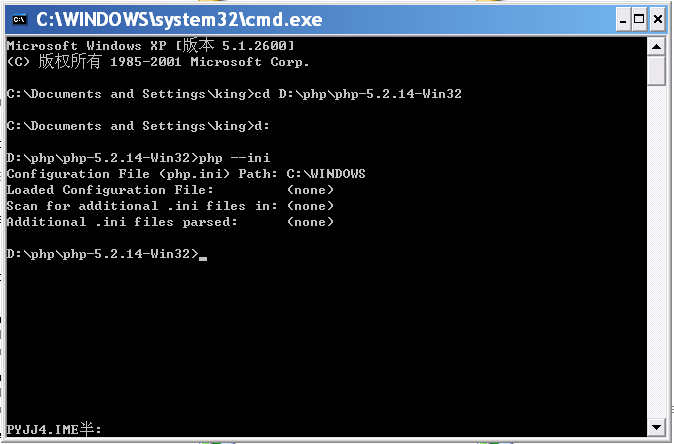Php是一個非常流行的web服務端腳本語言。其實,php不僅僅可以在web服務器中充當重要角色。在命令行一樣可以執行。
本文中,筆者為各位介紹下php在命令行中的使用方法。
在命令行中輸入php –v 即可查看當前php的版本。
Java代碼
其他的選項有: –m、-i。筆者在這裡就不給出列子了。
-m 會顯示當前php加載的有效模塊。
-i 則輸出無html格式的phpinfo。
使用 –ini 選項可以輸出當前php加載ini配置文件的數量、路徑信息。

從命令行運行php非常簡單。但有些注意事項需要各位了解下。諸如$_SESSION之類的服務器變量是無法在命令行中使用的,其他代碼的運行則和web服務器中完全一樣^_^。
Php代碼
把上面的代碼另存為hello.php 。在命令行中敲入 php –f hello.php。顯示結果如下:
在命令行中執行php文件的好處之一就是可以通過腳本實現一些計劃任務的執行。而毋須通過web服務器^_^。
當然,我們也可以直接在php中調試代碼:輸入php –r 指令,會出現一個”>”符號。這表示已經進入到php的shell中,可以直接寫代碼,並執行。
Java代碼
還可以使用php –a 命令打開交互模式,輸入一行代碼,php會實時輸出結果。
不用執行代碼,我們可以在命令行下檢測php文件的語法錯誤。
Java代碼
程序員經常會需要將php代碼高亮原樣輸出,使用php –s 即可
Java代碼
在浏覽器中的顯示效果

從php5.1.2開始,程序員們可以在php命令行下查看手冊了,輸入php –rf function。會打印出該函數的語法簡介
Java代碼
如果要查看類使用 –rc;查看擴展使用 –re。
Php命令行的使用方法介紹到這裡就結束了。Enjoy It!
來源:http://www.cnphp.info/php-command-line-useage-intro.html
更多:http://www.tutorialspoint.com/unix_commands/php.htm
php - PHP Command Line Interface ’CLI’
php [options] [ -f ] file [[--] args...]
php [options] -r code [[--] args...]
php [options] [-B code] -R code [-E code] [[--] args...]
php [options] [-B code] -F file [-E code] [[--] args...]
php [options] -- [ args...]
php [options] -a
PHP is a widely-used general-purpose scripting language that is especially suited for Web development and can be embedded into HTML. This is the command line interface that enables you to do the following:
You can parse and execute files by using parameter -f followed by the name of the file to be executed.
Using parameter -r you can directly execute PHP code simply as you would do inside a .php file when using theeval() function.
It is also possible to process the standard input line by line using either the parameter -R or -F. In this mode each separate input line causes the code specified by -R or the file specified by -F to be executed. You can access the input line by $argn. While processing the input lines $argi contains the number of the actual line being processed. Further more the parameters -B and -E can be used to execute code (see -r) before and after all input lines have been processed respectively. Notice that the input is read from STDIN and therefore reading from STDIN explicitly changes the next input line or skips input lines.
If none of -r -f -B -R -F or -E is present but a single parameter is given then this parameter is taken as the filename to parse and execute (same as with -f). If no parameter is present then the standard input is read and executed.
Tag Description
--interactive
Tag Description
php-cli.ini The configuration file for the CLI version of PHP. php.ini The standard configuration file will only be used when php-cli.ini cannot be found.
Tag Description
php -r ’echo "Hello World\n";’ This command simply writes the text "Hello World" to standard out. php -r ’print_r(gd_info());’ This shows the configuration of your gd extension. You can use this to easily check which image formats you can use. If you have any dynamic modules you may want to use the same ini file that php uses when executed from your webserver. There are more extensions which have such a function. For dba use:php -r ’print_r(dba_handlers(1));’ php -R ’echo strip_tags($argn)."\n";’ This PHP command strips off the HTML tags line by line and outputs the result. To see how it works you can first look at the following PHP command 'php -d html_errors=1 -i' which uses PHP to output HTML formatted configuration information. If you then combine those two 'php ...|php ...' you’ll see what happens. php -E ’echo "Lines: $argi\n";’ Using this PHP command you can count the lines being input. php -R ’@$l+=count(file($argn));’ -E ’echo "Lines:$l\n";’ In this example PHP expects each input line being a file. It counts all lines of the files specified by each input line and shows the summarized result. You may combine this with tools like find and change the php scriptlet. php -R ’echo "$argn\n"; fgets(STDIN);’ Since you have access to STDIN from within -B -R -F and -E you can skip certain input lines with your code. But note that in such cases $argi only counts the lines being processed by php itself. Having read this you will guess what the above program does: skipping every second input line.
You can use a shebang line to automatically invoke php from scripts. Only the CLI version of PHP will ignore such a first line as shown below:
#!/bin/php
<?php
// your script
?>
http://www.php.net/manual/
You can view the list of known bugs or report any new bug you found at:
http://bugs.php.net
The PHP Group: Thies C. Arntzen, Stig Bakken, Andi Gutmans, Rasmus Lerdorf, Sam Ruby, Sascha Schumann, Zeev Suraski, Jim Winstead, Andrei Zmievski.
Additional work for the CLI sapi was done by Edin Kadribasic, Marcus Boerger and Johannes Schlueter.
A List of active developers can be found here:
http://www.php.net/credits.php
And last but not least PHP was developed with the help of a huge amount of contributors all around the world.
This manpage describes php, version 5.2.17.
Copyright © 1997-2010 The PHP Group